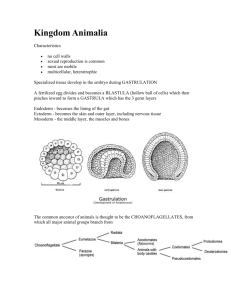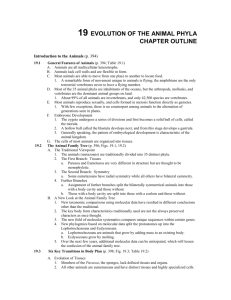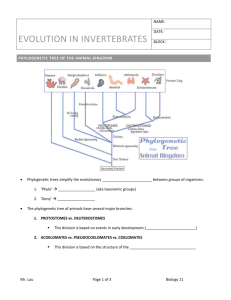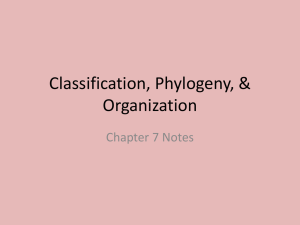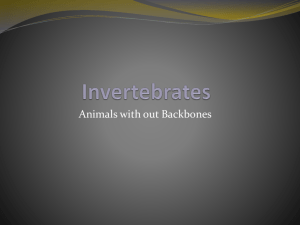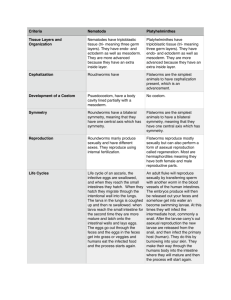IM_ch19
advertisement
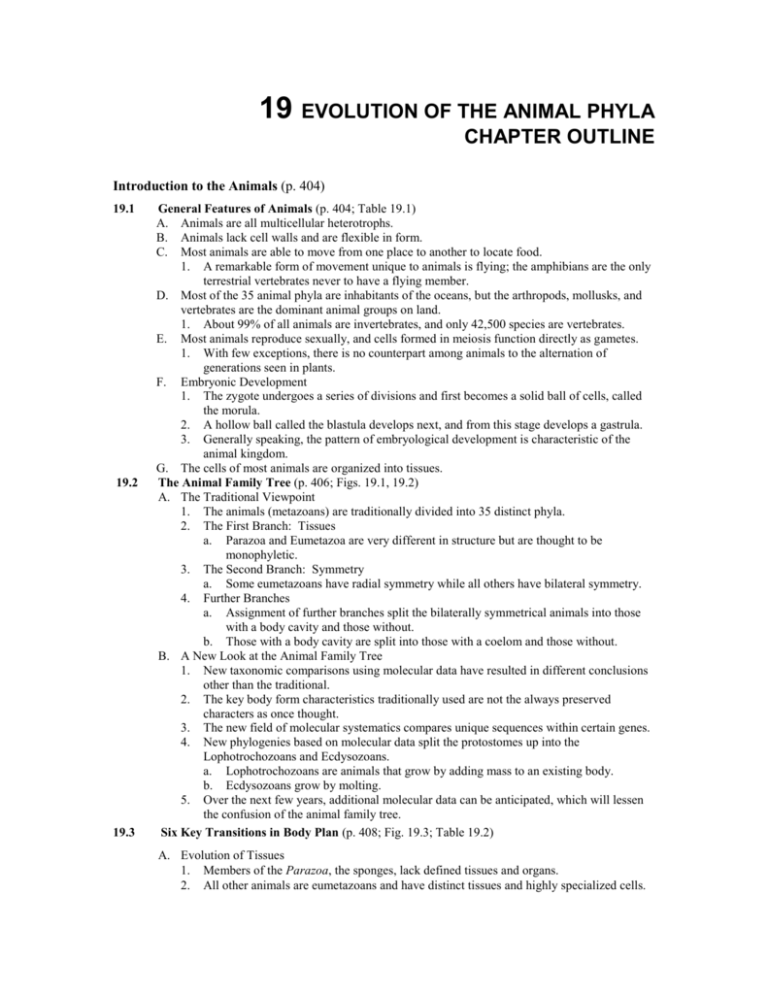
19 EVOLUTION OF THE ANIMAL PHYLA CHAPTER OUTLINE Introduction to the Animals (p. 404) 19.1 19.2 19.3 General Features of Animals (p. 404; Table 19.1) A. Animals are all multicellular heterotrophs. B. Animals lack cell walls and are flexible in form. C. Most animals are able to move from one place to another to locate food. 1. A remarkable form of movement unique to animals is flying; the amphibians are the only terrestrial vertebrates never to have a flying member. D. Most of the 35 animal phyla are inhabitants of the oceans, but the arthropods, mollusks, and vertebrates are the dominant animal groups on land. 1. About 99% of all animals are invertebrates, and only 42,500 species are vertebrates. E. Most animals reproduce sexually, and cells formed in meiosis function directly as gametes. 1. With few exceptions, there is no counterpart among animals to the alternation of generations seen in plants. F. Embryonic Development 1. The zygote undergoes a series of divisions and first becomes a solid ball of cells, called the morula. 2. A hollow ball called the blastula develops next, and from this stage develops a gastrula. 3. Generally speaking, the pattern of embryological development is characteristic of the animal kingdom. G. The cells of most animals are organized into tissues. The Animal Family Tree (p. 406; Figs. 19.1, 19.2) A. The Traditional Viewpoint 1. The animals (metazoans) are traditionally divided into 35 distinct phyla. 2. The First Branch: Tissues a. Parazoa and Eumetazoa are very different in structure but are thought to be monophyletic. 3. The Second Branch: Symmetry a. Some eumetazoans have radial symmetry while all others have bilateral symmetry. 4. Further Branches a. Assignment of further branches split the bilaterally symmetrical animals into those with a body cavity and those without. b. Those with a body cavity are split into those with a coelom and those without. B. A New Look at the Animal Family Tree 1. New taxonomic comparisons using molecular data have resulted in different conclusions other than the traditional. 2. The key body form characteristics traditionally used are not the always preserved characters as once thought. 3. The new field of molecular systematics compares unique sequences within certain genes. 4. New phylogenies based on molecular data split the protostomes up into the Lophotrochozoans and Ecdysozoans. a. Lophotrochozoans are animals that grow by adding mass to an existing body. b. Ecdysozoans grow by molting. 5. Over the next few years, additional molecular data can be anticipated, which will lessen the confusion of the animal family tree. Six Key Transitions in Body Plan (p. 408; Fig. 19.3; Table 19.2) A. Evolution of Tissues 1. Members of the Parazoa, the sponges, lack defined tissues and organs. 2. All other animals are eumetazoans and have distinct tissues and highly specialized cells. B. Evolution of Bilateral Symmetry 1. Animals with radial symmetry have body parts radiating around a central axis such that any plane passing through the central axis divides the body into mirror halves. 2. Animals with bilateral symmetry can be divided into left and right halves only through the median longitudinal plane; this allows different organs to be located in different body parts, and allows more efficient directional movement. C. Evolution of a Body Cavity 1. The evolution of complex organ systems was dependent upon the evolution of a body cavity for protection and support. 2. A body cavity provides space for storage of undigested food, more freedom of movement, and storage of gametes. D. The Evolution of Segmentation 1. In protostome animals (flatworms, nematodes, annelids, mollusks, and arthropods), the blastopore develops into the mouth. 2. In deuterostomes (echinoderms and chordates), the blastopore develops into the anus. E. The Evolution of Segmentation 1. In many segmented animals, each segment can develop a more or less complete set of adult organs so damage to one segment may not necessarily be fatal because others can duplicate that segment’s functions. 2. Segmentation allows more flexibility and more complex movements. The Simplest Animals (p. 411) 19.4 19.5 Sponges: Animals Without Tissues (p. 411; Fig. 19.4) A. Two subkingdoms exist within the Kingdom Animalia: Parazoa have no symmetry, are not differentiated into tissues or organs, and consist mostly of the sponges, while Eumetazoa show symmetry and have tissues and organs. B. Members of the Parazoa, the sponges, are simple, asymmetrical animals whose bodies are not organized into tissues but whose cells recognize each other. C. The sponge body consists of specialized cells housed in a gel-like matrix. D. Sponges live anchored to the bottom of ocean surfaces and filter water, eating tiny organisms. E. Cells called choanocytes possess flagella that beat rhythmically, drawing water into the sponge cavity. F. There are 5,000 or so species of these filter feeders. Cnidarians: Tissues Lead to Greater Specialization (p. 414; Figs. 19.5, 19.6, 19.7) A. Eumetazoans show body symmetry and have tissues. B. Radially symmetrical eumetazoans have two embryonic layers: an outer ectoderm, which gives rise to the epidermis, and an inner endoderm, which gives rise to the gastrodermis; a jellylike layer called the mesoglea forms between the epidermis and gastrodermis. C. The most primitive members of the subkingdom Eumetazoa are in the phyla Cnidaria and Ctenophora. These animals show radial symmetry, with body parts arranged like the spokes of a wheel around an axle, and are grouped as Radiata. D. A major evolutionary innovation among the radiates is the extracellular digestion of food. E. Cnidarians 1. Cnidarians are represented by the hydra, jellyfish, corals, and sea anemones. 2. Cnidarians are carnivores that possess stinging nematocysts to harpoon and capture prey. 3. They have an interior gut cavity that has evolved to enable extracellular digestion, which is digestion within a cavity rather than within individual cells. 4. Two body forms are seen in cnidarians, a free-floating medusae form, and an attached polyp form. 5. In some species of cnidarians, alternation between these two forms is seen during their life cycle. F. Ctenophorans 1. Ctenophorans include the comb jellies, the largest animals that use cilia for movement. The Advent of Bilateral Symmetry (p. 417) 19.6 Solid Worms: Bilateral Symmetry (p. 417; Figs. 19.8-19.12) A. In more advanced groups of metazoans, bilateral symmetry evolved, which allows cephalization, or development of a head end, plus provides for different body surfaces (i.e., ventral, or belly-side; dorsal, or opposite to belly-side; anterior, or front; and posterior, or back). B. The bilaterally symmetrical eumetazoans have three germ layers, ectoderm, mesoderm, and endoderm. C. The simplest of the bilaterally symmetrical animals are the solid worms. D. Solid worms called flatworms (phylum Platyhelminthes) are numerous, comprising 20,000 species. E. In this group, organs evolved; organs are groups of different tissues functioning together as units. F. Solid worms have a digestive tract but no other body cavity, and are thus acoelomate (without a body cavity). G. Flatworms 1. Flatworms are simple in design yet possess a head, and range in size from a millimeter to several meters in length. 2. Flatworms may be free-living or parasitic; free-living forms are carnivores or scavengers. 3. Flukes and tapeworms make up the two classes of parasitic flatworms. 4. Important human parasites include the liver fluke, and blood flukes of the genus Schistosoma, which cause schistosomiasis. H. Characteristics of Flatworms 1. Flatworms cannot feed continuously. 2. They have a gut that branches and functions both in digestion and food distribution; food particles enter and exit the single opening to the gut. 3. Flatworms have a simple excretory system with cilia and flame cells. 4. Flatworms lack a circulatory system and have a very simple nervous system. 5. The reproductive systems of flatworms are complex, and most flatworms are hermaphroditic. The Advent of a Body Cavity (p. 421) 19.7 Roundworms: The Evolution of a Body Cavity (p. 421; Figs. 19.13, 19.14) A. An internal body cavity evolved in bilaterally symmetrical animal groups other than the solid worms. B. This was an important improvement because a cavity allows for circulation, greater movement, and independent organ function. C. Kinds of Body Cavities 1. Acoelomates have no body cavity. 2. Pseudocoelomates have a body cavity called a pseudocoel located between the mesoderm and endoderm. 3. Animals with a coelom have a fluid-filled cavity that develops entirely within the mesoderm. 4. The problem of diffusion in coelomates is solved by the evolution of a circulatory system. 5. In an open circulatory system, the blood passes from vessels into sinuses, mixes with body fluid, and reenters the vessels in another position. 6. In a closed circulatory system, the blood is separate from the body fluid and can be controlled separately. D. Roundworms: Pseudocoelomates 1. Seven phyla of animals are pseudocoelomates, or animals with a pseudocoel that develops between endoderm and mesoderm. 2. The pseudocoel serves as a hydrostatic skeleton against which the animal’s muscles can work. 3. 19.8 19.9 19.10 The largest pseudocoelomate phylum is Nematoda, which includes 20,000 species of nematodes, eelworms, and other roundworms. A second pseudocoelomate group, the rotifers (phylum Rotifera), are small aquatic creatures with a crown of cilia on their heads to propel them through the water. 4. All pseudocoelomates lack a defined circulatory system but most have a one-way digestive tract that permits specialization of different areas or organs within the tract E. Nematoda: The Roundworms 1. Nematodes are abundant and found everywhere; many are microscopic and found in soil; other are parasites of animals and plants. 2. Nematodes are covered with a thick cuticle, which is molted as they grow. 3. About 50 species of nematodes regularly parasitize human beings. 4. Trichinosis is a disease caused by nematodes and is contracted by eating undercooked pork. Mollusks: Coelomates (p. 424; Fig. 19.15) A. Coelomates 1. Coelomates are animals that possess a true coelom, or fluid-filled body cavity contained completely within the mesoderm. 2. Having this arrangement allows for the development of specialized tissues during the embryonic period by a process called primary induction. 3. During this process, there is a complete interaction of the three germ layers, not seen before in pseudocoelomate or acoelomate animals. 4. This interaction led to the evolution of complex digestive tracts. B. Mollusks 1. The mollusks are the most primitive coelomates, but are highly diverse, with over 110,000 species. 2. All mollusks have a head-foot, a central portion containing most body organs, and a mantle, which is a heavy coat of tissue attached interiorly to the breathing apparatus, the gills. 3. Three groups of mollusks are gastropods, bivalves, and cephalopods. 4. These groups differ in their arrangement of the basic mollusk body plan. 5. One of the most characteristic features of the mollusks is a radula, a rasping tongue-like organ used to scrape food off rocks or to puncture prey. Annelids: The Rise of Segmentation (p. 426; Fig. 19.16) A. The next key evolutionary advance, segmentation, arose among the coelomates. B. A segmented body plan involves a series of identical segments, each physically separated from the next, and each of which can evolve independently to produce a new structure and function. C. The annelid worms, phylum Annelida, were the first segmented animals. D. Annelids show repeated segments, segments that are specialized for a particular function, and connections between segments, such as a circulatory system. Arthropods: Advent of Jointed Appendages (p. 427; Figs. 19.17-19.25) A. The evolution of segmentation enabled the innovation of jointed appendages. B. Jointed Appendages 1. Development of jointed appendages in the arthropods, phylum Arthropoda, led to an explosion of different kinds of species. 2. Without jointed appendages, it is impossible to walk, fly, or sense environmental change with antennae. C. Rigid Exoskeleton 1. Arthropods also developed a rigid, chitinous exoskeleton on the outsides of their bodies, which provided a point for muscle attachment. 2. One drawback of an exoskeleton was that it prevented arthropods from reaching the immense sizes seen in some of the early vertebrates that had internal skeletons. 3. Because of their body design, arthropods are very successful, and two-thirds of all named species are arthropods. D. Chelicerates 1. Arthropods that lack jaws (mandibles) are called chelicerates, and include spiders, mites, and scorpions. 2. The largest of the three classes of chelicerates are the mostly terrestrial Arachnida, with 57,000 species of spiders, ticks, mites, and scorpions. E. Mandibulates 1. Arthropods possessing mandibles that evolved from anterior appendages are called mandibulates. 2. Examples of the mandibulates include the crustaceans, centipedes, millipedes, and insects. 3. The crustaceans are a large, diverse group of mostly aquatic organisms, including 35,000 species of crabs, shrimps, lobsters, crayfish, barnacles, water fleas, pillbugs, and others that play a crucial role in aquatic ecosystems. 4. Millipedes and centipedes are closely related to insects and have one pair of legs (centipedes) or two pairs of legs (millipedes) per body segment. 5. Most centipedes are carnivores with venomous fangs, while most millipedes are herbivores. 6. The insects, class Insecta, are the most successful group of arthropods, with about 1 million known species. 7. Insects have an elaborate head, a thorax with three segments, each giving rise to a pair of legs and usually two pairs of wings, and a segmented abdomen. Redesigning the Embryo (p. 434) 19.11 19.12 19.13 Protostomes and Deuterostomes (p. 434; Figs. 19.26) A. The coelomate animals fall into two categories, depending on the course of their embryologic development. B. Most animal embryos start as hollow balls of cells, then indent to form two-layered balls that open to the outside. C. In protostomes, the mouth of these embryos develops at or near this opening, which is called the blastopore. 1. Even noncoelomate animals develop in this manner. D. In deuterostomes, the anus develops at or near the blastopore, and the mouth develops later from another part of the embryo. E. Radial cell division also arises in deuterostomes, while cell division is spiral (spiral cleavage) in protostomes. F. In protostomes, differentiation occurs earlier during embryologic development, so the fate of each cell cannot be altered; in deuterostomes, the first cell divisions produce identical cells, any of which can develop into an entire organism. G. Also, the coelom develops differently in protostomes versus deuterostomes. Echinoderms: The First Deuterostomes (p. 436; Fig. 19.27) A. The first deuterostomes were the echinoderms, which are marine animals of the phylum Echinodermata. B. They possess an endoskeleton made up of hard plates below the skin. C. The 6,000 species of echinoderms include starfish, sea urchins, and sand dollars, among others. D. Echinoderms begin life as bilaterally symmetrical larvae but end up as radially symmetrical adults with a unique body design. E. The nervous system consists of a central ring that gives rise to branches. F. They also have a water hydraulic system that, with the aid of tube feet, allows them to attach themselves and move along the bottom of the sea. Chordates: Improving the Skeleton (p. 438; Figs. 19.28, 19.29) A. General Characteristics of Chordates 1. The chordates are deuterostome coelomates that developed after the echinoderms and possess an even more advanced endoskeleton. 2. Chordates also have a dorsal notochord that allows for back and forth swimming motions. 3. A nerve cord follows this notochord and branches out to different portions of the body. 4. A series of pouches behind the mouth, called the pharyngeal pouches, is also present during at least part of the life of all chordates. 5. A postanal tail is present during embryonic development in all chordates and beyond in many species. B. Vertebrates 1. Most chordates are vertebrates that have a well-defined head and a backbone, plus an internal skeleton made up of bone or cartilage. KEY TERMS Parazoa (p. 406) The Parazoa are animals without symmetry, tissues, or organs. Eumetazoa (p. 406) The Eumetazoa are animals that have a definite shape and symmetry. choanocytes (p. 412) Flagellated cells in sponges. radial symmetry (p. 408) Symmetrical about a central axis. ectoderm (p. 414) endoderm (p. 414) nematocyst (p. 416) The stinging weapon of the cnidarians. medusae (p. 416) polyp (p. 416) bilateral symmetry (p. 408) Having a right and left half, mirror images of each other. mesoderm (p. 417) cephalization (p. 417) The process of developing a head end. acoelomate (p. 417) Solid body construction. pseudocoelomate (p. 421) Having a body cavity between the mesoderm and endoderm. coelom (p. 421) A body cavity that develops entirely within the mesoderm. coelomates (p. 421) Possessing a coelom. mantle (p. 424) radula (p. 424) The rasping tongue-like organ of mollusks. segmentation (p. 426) The building of a body from a series of similar segments. exoskeleton (p. 428) Rigid, external skeleton. protostome (p. 434) Mouth forms before anus. deuterostome (p. 434) Mouth forms after anus. endoskeleton (p. 436) An internal skeleton. spiral cleavage (p. 434) radial cleavage (p. 434) endoskeleton (p. 436) notochord (p. 438) Flexible rod along the back of the embryo in Chordates.
